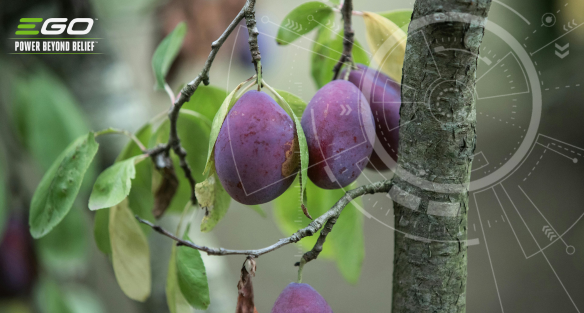Pruning most trees and shrubs from late autumn to late winter, when the sap falls and the plant enters dormancy, is a common practice. This timing helps avoid the risk of the plant going into shock, especially if you accidentally prune too much off the plant. Understanding the ideal pruning time can significantly improve your gardening practices.
However, cherry, plum, and damson trees are an exception. These trees are better suited to pruning in midsummer when the sap is high to prevent silver leaf disease.
What is silver leaf disease?
Silver leaf is a fungal infection that commonly affects cherry, plum, and damson trees. Roses, hawthorns, and apricots, which are members of the same family, can also contract silver leaf. Although it's much less common, the disease can also affect apple trees.
The fungus that causes the disease, Chondrostereum purpureum, causes the leaves of the infected tree to appear silver. This is the result of the fungus infecting the wood underneath the bark, causing the leaves of the infected branch to change colour. It’s also a progressive disease, meaning it gets worse over time if left untreated and can even result in the death of the tree if the infection reaches the trunk.
Symptoms of silver leaf disease
You can tell if your plum, cherry or damson tree has contracted silver leaf from the following symptoms:
- Leaves turning silver in colour—leaves with a silver-like appearance, particularly on the side of the leaf, are a sign that your tree has the disease.
- Branches die back—the branches that the fungus has infected may completely wither and die. The same goes for the trunk, too, causing the death of the tree.
- Flat toadstools grow on the tree—usually on branches but also on the trunk. These toadstools are the fruiting bodies of the fungus that causes silver leaf. They are initially purple, but they turn orange-brown come autumn.
- Discolouration of the wood - dark brown marks can be seen in the wood if you were to cut through an infected branch.
Prune in summer to prevent silver leaf
To prevent silver leaf from taking hold of your fruit trees, you should prune them mid-summer. This is because the spores of the fungus that cause the disease thrive in the damp, mild conditions of winter. In summer, these spores are much less common.
The wounds from pruning, which are a point of entry for the fungus, heal quicker at this time of year than in autumn and winter.
For in-depth advice on pruning, you can read our guidance on pruning your apple trees. Except for the timing, the principles are the same. If you’re after a quick overview of some pruning tips, here’s what you need to know:
1. Prune between July and late September
Pruning between July and late September helps you avoid the risk of frost damaging any new growth resulting from pruning. It also means you prune outside the flowering window, typically from April through to June.
2. Start with dead, diseased and damaged wood
Begin by looking for dead, diseased, or damaged wood before pruning the healthy wood. If you spot any, cut it off and then assess the rest of the tree.
3. Remove any rubbing or crowded branches
Any branches that are rubbing or causing the centre of the tree to be crowded should be removed. Branches that are rubbing are hotspots. The same goes for branches that crowd the centre of the tree, as they trap moisture and reduce airflow through the tree.
4. Follow the ⅓ rule
When you prune, cut no more than ⅓ off each branch you cut back. You should also not prune any more than ⅓ off the tree as a whole. This ensures that the tree has enough leaves to photosynthesise and store energy for new growth and to heal the pruning wounds.
5. Properly dispose of any infected wood
Any branches that are showing signs of disease should be disposed of by burning them. This destroys the infection and prevents it from spreading to other trees. The ash can then be used in the garden because it’s a great source of potash - an essential nutrient that aids flowering, fruit production and disease resistance.
Browse the EGO gardening calendar for more garden tips
Our new gardening calendar is organised season by season. Now you know what gardening jobs need doing and when to have a healthy and thriving garden year after year.
Also, there is plenty of information on maintaining many of your EGO cordless garden tools as you go about your gardening throughout the year. Have a browse through and expand your gardening knowledge and put it into practice with the help of the EGO range.
